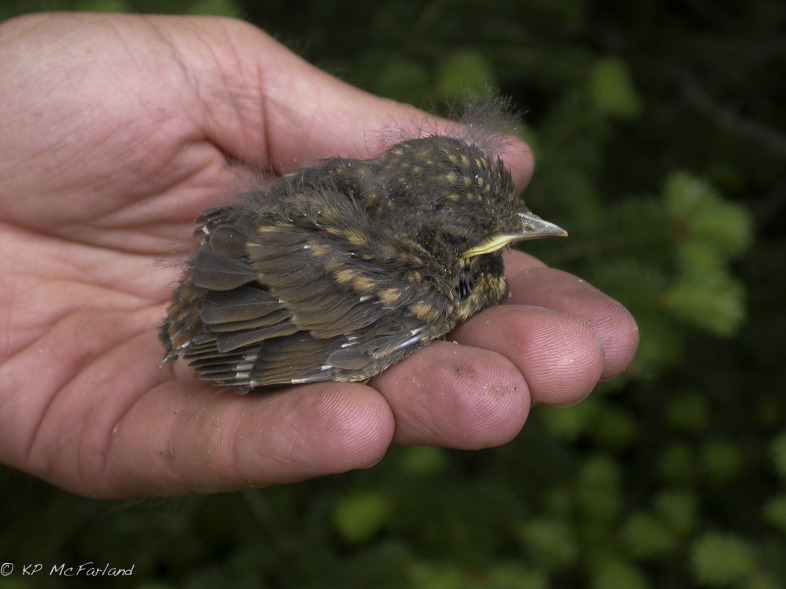They say that miracles only happen once, but for VCE biologists a miracle with wings has now hit their nets three times.
Nearly 20 years ago under a dark, tropical forest canopy on a remote Dominican Republic mountain the first miracle appeared just before dawn. With a bird net as fine as forest mist strung between two poles, Kent McFarland crouched in nearby undergrowth and pushed play on his recorder.
The plaintive calls of a Bicknell’s Thrush whistled from the speaker in regular intervals. “Peeer….peeer….peeer.” From the dark forest a reply came almost immediately. It then gave a couple agitated growls and darted from the understory landing headfirst in the black net.
In the twilight, McFarland and fellow biologist Jim Chace, hurried to the net. A thrush hung safely in the mesh. But it wasn’t just any Bicknell’s Thrush. It was a Vermonter. The tiny aluminum leg band with a unique set of nine digits, like an avian social security number, told the story.
The Bicknell’s thrush they netted on December 2nd in an isolated tropical forest turned out to be the very same individual they had caught and banded six months earlier on the slopes of Mt. Mansfield.
Imagine a songbird – weighing just one ounce, captured on Vermont’s highest mountain, equipped with a tiny metal band – released to the wild. It migrates down the Atlantic coast, across ocean waters to a country the size of Vermont and New Hampshire combined only to be recaptured by the same ornithologists.
“Looking back on it, I think the odds are a bit like being hit by lighting while winning the lottery,” said McFarland nostalgically. “And what is even more remarkable is that it was the first bird I personally ever captured in the Dominican Republic.”
But if that lone thrush represented a miracle, the next feat was utterly indefinable. Seven years later on a remote mountain in the Sierra de Neiba mountain range in central Dominican Republic, Jason Townsend, a VCE research associate, held a thrush in his hands with a shiny silver band already around its leg.
“That night by headlamps we poured over the master list of band numbers to search out who this bird might be, but [we] were disappointed to find no such band number on the list,” recalls Townsend. “But then the thought hit us that perhaps this was a bird banded elsewhere.”
Several weeks passed before Townsend made his way out of the mountains and was able to contact Chris Rimmer back in Vermont. “Hold on to your hats,” wrote Rimmer in an email. The bird was a Vermonter.
Although the Sierra de Neiba was formally given park status in 1995, several rapid assessments by VCE scientists uncovered ongoing illegal logging and slash-and-burn agriculture throughout the unpatrolled park. Bicknell’s Thrushes were found in the remaining fragments of forest. The rapid assessment teams were able to capture, band and release twenty thrushes, including one that haled from Stratton Mountain, Vermont.
On a hot day in early July 2002, McFarland and biologist Ben Flemer quietly visited a thrush nest that they had been monitoring for several weeks. The chicks were 7 days old. It was time to band them. Each of the four nestlings only sported sparse downy feathers and newly-opened eyes. Together, all four barely covered McFarland’s palm as he handed them to Flemer to band. With a new silver band on each bird, McFarland placed them gently back in the nest. A week later, they had grown enough to leave the nest. Most young birds never make it to their first birthday, but five months later, at least one of these chicks was alive and well in the Sierra de Neiba.
The Hat Trick
With the help of flocks of students and biologists, VCE just completed the 23rd summer of banding thrushes on Vermont’s highest peak. They’ve amassed a database of over 575 individual thrushes with some captured dozens of times. From peaks across the breeding range in Northeast to remote ridges in the Dominican Republic and Haiti, VCE biologists have captured and banded over 2,000 thrushes. But even after all these years, a miracle on wings still amazes these seasoned biologists.
“We’re still shaking our heads over the latest unlikely twist,” said Rimmer.
He’d noticed a thrush he captured had a very worn and dull band that had clearly been around for many years. “I figured this was yet another old-timer,” said Rimmer.
This was nothing unusual for the biologists. They learned years ago that these small songbirds could sometimes live to be a decade old. Just the week before they recaptured a thrush that was first banded on Mt. Mansfield 9 years ago. These birds have what is called strong site fidelity. They come back to the same mountain to breed year after year after year, and these biologists have been there to greet them.
Later that morning Rimmer opened his laptop to check the database. “ I was surprised to see an original banding date of February 13, 2010. Looking more closely, I was astonished to note that the banding site was a scientific reserve in the Dominican Republic’s Cordillera Septentrional,” exclaimed Rimmer.
VCE biologists Pat Johnson and Juan Klavins had banded the bird and fitted a miniature geolocator backpack on it in hopes of recapturing it the following year in the reserve and finding out where it had traveled to breed. They were unable to recapture it to retrieve the data, but now Rimmer knows exactly where it spent its summer that year.
“These remarkable encounters underscore the tight migratory connectivity between Vermont and the Dominican Republic,” says Rimmer in retrospect. “As I said before, we’re still shaking our heads in amazement.”


An astounding and absolutely inspiring bit of research, Doc et al. Keep up the GREAT work-